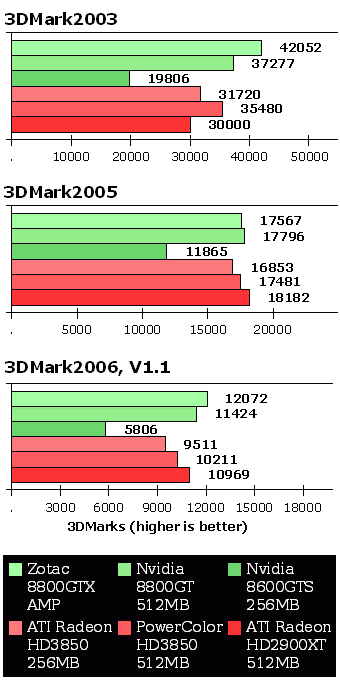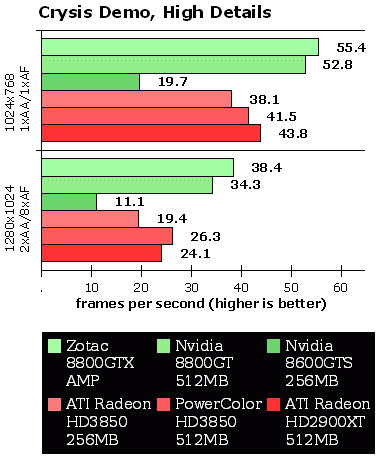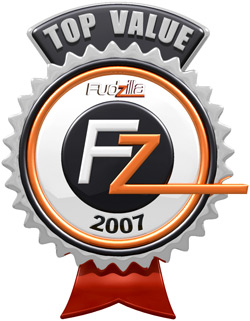Today, PowerColor has unveiled their lineup of regular and overclocked Radeon HD 3850 and HD 3870 cards, and both have finally blessed the lower priced market segment with HD gaming and quality multimedia characteristics. The HD 3850 and HD 3870 are based on the first 55nm graphics chips, so PowerColor decided to overclock a couple, with a little help from some additional cooling, of course. The HD 3870 should compete with the recently launched 8800GT, although the 8800GT will prove to be a fierce competitor. The HD 3850, on the other hand, is a less pricey version, and its rival is supposed to be the 8800 GT 256MB. ATI’s new cards follow the new branding trend, which basically follows a simple rule – the higher the model number, the better the card.
PowerColor has made a jumpstart and we hope that their overclocked card is good enough to handle the competition. Overclocking further burdens the graphics chip, so to compensate for the additional heat, PowerColor opted for a Zerotherm cooler. The overclocked HD 3850 features what PowerColor refers to as the Professional Cooling System, or PCS for short, and it is optimized by Zerotherm; and we’ve just finished testing one of the cards featuring PCS.

The full name of the card is PowerColor HD 3850 Xtreme PCS and it's clocked at 720MHz. The small 55nm chip isn’t as cool as we had expected, at least not with the reference cooler. With reference cooling, the temperature often rose to 89 degrees Celsius, but we must say that the cooler stays quiet. The cooler didn’t automatically adjust the fan speed to the changes in temperature.

Unlike the reference card, PowerColor's cooler is a bit louder, but the core temperature didn’t exceed 54°C, not even while gaming. The fan ran at maximum RPM all the time, and it resulted in temperatures of about 38°C in idle mode.

The Radeon HD 3850 reference clock is 668MHz, so you can see that PowerColor overclocked it to 720MHz. PowerColor also opted for 512MB of GDDR3 memory, while the reference cards only have 256MB of GDDR3. The Xtreme card features Samsung memory which can operate at speeds of up to 1,000MHz, but on the card it runs at 900MHz (1,800MHz effectively ). This allows for additional overclocking, but we didn’t manage to pull it off with our current OC tools.
The RV670 architecture is basically the same as the R600, and the 55nm process is a result of shrinking the R600’s 80nm die. However, numerous changes have been made, and many things were optimized. The Radeon HD 3850 and HD 3870 kept the 320 Stream processors, but the 512-bit memory controller was replaced with a new 256-bit controller, which is better optimised.
The UVD engine, a feature that has so far been exclusive to AMD's mid-range cards, is featured on this card. It enables full acceleration of High Definition movie formats, such as H.264 and VC-1. HDMI and sound support is a standard feature on ATI HD cards, and PowerColor is among the first ones to provide HDMI out directly on the card, so there’s no need for a DVI-to-HDMI dongle.

This is the first ATI card with PCI Express 2.0 interface, and we’ve recently seen that the 8800 GT packs the same. However, ATI has DX10.1 support as an ace up its sleeve, and Nvidia can’t say the same for their cards. We’re talking evolution of standards, and we’ll see it in action once Vista service pack 1 comes out sometime next year. DX10.1 brings Shader Model 4.1 with improved antialiasing, lighting, Shader instructions and many other things that are yet to be utilized.

You can clearly see that PowerColor's design is different from the reference design. The PCI Express power connector and CrossFire connectors are still the same, though. However, there are two completely new features here. CrossFireX is similar to Nvidia's quad SLI technology, and might even be better. You can link together up to four HD 3850 or HD 3870 cards and decide whether you want multi GPU rendering, or just use video out on each of the cards, which would allow for a total of eight monitors. Overclocking such a system would be an overclocker's dream, but only if ATI delivers on their promises of CrossFireX overclocking. Quad SLI 3D rendering is still questionable, and we’ll see if ATI’s any luckier.
The other new feature is ATI's PowerPlay technology, and we think that it’ll prove to be quite useful for the end user. Thanks to a special controller, the RV670 has power management in the core. That means controlling the power usage of the GPU, and lower power consumption. By constantly monitoring the core's power usage, it’s possible to alter the voltages or even turn off parts of the chip that aren't in use. PowerPlay is much more than just downclocking the graphics core when in 2D mode.
ATI claims that PowerPlay should limit consumption to 35W during regular use (non-gaming) and a bit over 50W during ‘light’ gaming. The maximum power consumption for the HD 3870 is 105W, while it's a mere 95W for the HD 3850.


The box is nice, and its content is fairly standardl, but there are no games, at least not with the sample we received.
Testbed
Motherboard:
EVGA 680i SLI (Supplied by EVGA)
Processor:
Intel Core 2 Duo 6800 Extreme edition (Supplied by Intel)
Memory:
OCZ FlexXLC PC2 9200 5-5-5-18 (Supplied by OCZ)
during testing CL5-5-5-15-CR2T 1066MHz na 2.2V
PSU:
OCZ Silencer 750 Quad Black ( Supplied by OCZ)
Hard disk:
Seagate Barracuda 7200.9 80GB SATA (Supplied by Seagate)
CPU-Cooler:
Freezer 7 Pro (Supplied by Artic Cooling)
Case Fans:
Artic Cooling - Artic Fan 12 PWM
Artic Cooling - Artic Fan 8 PWM
3DMarks

New RV670 cards perform well in 3DMarks, especially Power Color Extreme HD, and you see that it definitely beats the reference design card. In 3DMark06, the overclocked card is faster than reference card by seven percent, and slower from HD2900 XT by four percent. Gaming will also prove that Power Color Extreme PCS is far better than reference card.
In Futuremark, Geforce 8800 GT beats ATI cards by a small margin, but it runs better when gaming, especially with antialiasing on.
Here are the results in a few currently popular games, and they aren't quite what we expected. Geforce 8800 GT is quite popular, and we are mighty curious as to what ATI’s cards can do. Sadly, we didn’t manage to get an HD 3870, so HD3850 is alone by itself in these tables, and compared to Geforce 8800 GT its results don’t look good. Yes, this comparison is quite unfair, but 8800 GT 256MB is virtually impossible to find at this point. However, as we’ve seen many times before, the performance gap between 256MB cards and their 512MB colleagues is not that great, so HD3850 competing against Geforce 8800 GT 256MB is quite unlikely.
Company of Heroes ( Opposing Fronts )

Power Color HD 3850 beats ATI’s reference card by 15 percent, on all resolutions, but loses to HD 2900XT by about 10 percent. Power Color did a good overclocking job, and it definitely improved HD 3850’s low scores. Compared to HD 2900XT, the reference card loses by over 25 percent. Resolution of 2048x1536 allows for pleasant gaming, although 8800 GT beats Power Color HD 3850 by 56 percent.
F.E.A.R.

F.E.A.R. is the only game where performance gaps are minimal. At 2048x1536, Power Color loses to 8800 GT by 18 percent and to HD 2900XT by 12 percent. Again we see a good effort by the overclocked card, which beats the reference card by 18 percent. 39fps enables for problem free gaming.
S.T.A.L.K.E.R.

Power Color HD 3850 constantly beats the reference design by 13 percent, but it loses to HD 2900XT by the same margin. You can see that Power Color’s card performs well, and that it churns out more than enough fps for regular gaming. We used maximum detail in all the games, and even that wasn’t enough to take HD 3850 down.
World In Conflict
We’re used to seeing high-end cards handling the games well, but that, it seems, is in the past. In World in Conflict, we used maximum details, but the results are so bad that it’s not worth even talking about.

In this test, Nvidia overran ATI. New drivers would probably make HD 3850 scores higher, but we only had the Beta driver. Although Power Color HD 3850 performs poorly at 2048x1536, it’s still 55 percent better than ATI’s reference card.
Crysis

Conclusion
With their new generation of cards based on RV670, ATI brought a couple of new features, as well as some improvements to R600 design, such as high power consumption and a hot processor. The new 55nm chip runs much cooler and saves power, especially now that PowerPlay is here. We can’t forget the ZEROtherm cooler that easily outperforms ATI’s reference coolers.
One more novelty is PCI Express 2.0 with double the standard bandwidth. You probably won’t need it any time soon, but it won’t hurt. Unlike 8800 GT, the card supports DX10.1, but we won’t reap the rewards until the Vista service pack arrives.
Power Color HD 3850 Extreme PCS is a prince of HD 3850 generation. The core runs at 720MHz and the memory at 900MHz. The card itself is faster than reference card by 15 percent. Another cool thing that greatly improved this card’s score is the fact that it packs double the memory of reference cards. We’re talking about 512MB GDDR3 memory, compared to reference 256MB.
HD 3850 Extreme enables flawless gaming, but higher resolutions with antialiasing on prove to be a bit of a challenge for RV670. If you’re looking for HDMI capabilities, then look no further – Power Color HD 3850 Extreme PCS is THE card for HDMI. It’s unlikely that you’ll find another card with native HDMI connector in this price range. UVD is implemented so High Definition content is a piece of cake for HD 3850 Extreme card.
The price is still unknown, but since the reference PowerColor HD 3850 256MB is priced at €143, we’re expecting the price to be around €165, which is still very reasonable for a card in this class; so, the HD 3850 series gets our Top Value award.



